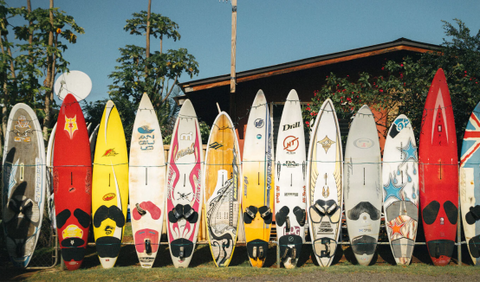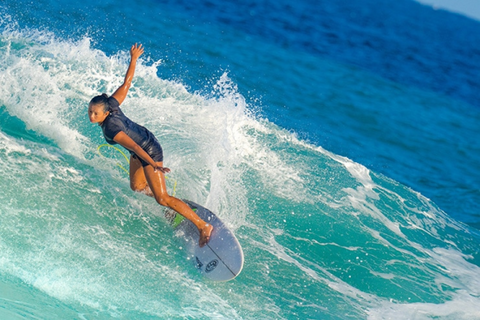Water sports have surged in popularity, with paddle boarding and surfing leading the wave of interest. These activities offer unique ways to connect with nature, providing both tranquility and adrenaline. However, for beginners, choosing between the two can be daunting. This discussion aims to dissect the paddle board vs surfboard debate, highlighting their differences in design, usage, and essential preparation. Our goal is to demystify which of these beloved water sports is more challenging for newcomers to master.

Design differences between paddle board vs surfboard
At first glance, paddle boards and surfboards share a familial resemblance: both are sleek, designed to cut through water, and require a balance of grace and strength from their riders. However, the devil is in the details, or in this case, the design.
- Paddle Boards: These are the gentle giants of the sea. Typically longer, wider, and thicker than surfboards, paddle boards offer more stability and are designed for standing up with ease. Their size makes them ideal for cruising on calm waters, and their volume allows for carrying additional gear or a furry friend. You’ll find variations like the all-around, touring, and racing paddle boards, each tailored to different water adventures.
- Surfboards: The surfboard, on the other hand, is built for agility and speed. Shorter and narrower, with a pointed nose and a set of fins for precision steering, surfboards are crafted to dance with the waves. The shape of a surfboard is a testament to its purpose: catching and riding waves with fluidity and grace. From shortboards designed for quick turns to longboards that glide over waves, each surfboard is a key to unlock the ocean’s rhythm.
Different usage and experience
- Paddle Boarding: Imagine gliding over crystal-clear waters, with every stroke of the paddle pulling you into a world of tranquility. Paddle boarding is not just about balance; it’s a full-body workout that improves core strength, cardiovascular health, and mental well-being. It’s versatile, perfect for a serene morning on a lake, exploring coastal inlets, or even engaging in SUP (Stand Up Paddleboard) yoga.
- Surfing: Now picture yourself waiting for the perfect wave, paddling fiercely as it approaches, then popping up on your surfboard to ride the liquid curve. Surfing is a thrilling dance with nature, requiring timing, precision, and a dash of daring. It’s a sport that teaches patience, respect for the ocean, and the joy of riding waves. Whether you’re carving up a storm on a shortboard or cruising on a longboard, surfing is about the pursuit of the perfect wave.
Tricks and treasures with paddle board vs surfboards
Both of the two sports offer a playground for creativity and skill beyond the basics. Let's dive deep into the tricks, treats, and treasures you can unlock with each board.
Paddle board wonders
- SUP Yoga and Fitness: Imagine perfecting your warrior pose as the sun rises, with the gentle sway of water beneath you. Paddle boards offer a floating mat for yoga enthusiasts seeking tranquility and challenge in their practice. But why stop there? SUP fitness classes take traditional workouts and bring them onto the water, adding an element of balance and core strength to every squat, push-up, and plank.
- Fishing and Exploration: With the stability and space of a paddle board, anglers and adventurers have found a new way to enjoy their hobbies. Equip your board with a cooler, fishing gear, or even a seat, and you’re set for a day of catching fish or exploring uncharted waters.
- SUP Racing and Touring: For the competitive at heart, SUP racing challenges speed and endurance on the water. Touring boards are designed for distance, allowing paddlers to embark on long expeditions across lakes, rivers, and coastal waters, discovering the world from a unique vantage point.

Surfboard stunts
- Carving and Snapping: Surfing isn’t just about riding waves; it’s about how you dance with them. Carving refers to making broad, sweeping turns across the wave's face, while snapping involves quick, sharp turns atop the wave, showcasing a surfer's agility and control.
- Aerials and Tubes: For the daredevils, aerial maneuvers launch surfers off the wave and into the air, turning the ocean into their own personal skatepark. Meanwhile, tube riding – gliding through the hollow curve of a wave – remains the holy grail of surfing, offering an unparalleled rush.
- Longboard Cross-Stepping and Nose Riding: Longboarding brings a graceful element to surfing, with cross-stepping allowing surfers to walk up and down the board as they glide along a wave. Nose riding, or hanging ten, where a surfer stands at the very front of the board, toes dangling over the edge, epitomizes cool under pressure.

Essential equipment and preparations for paddle boarding and surfing
Whether you're planning to catch waves at dawn or paddle through a serene sunset, having the right gear and making the necessary preparations can make all the difference. Here's what you'll need to embark on your paddle boarding or surfing journey, along with tips for getting started.
Paddle boarding essentials
- The Board: Choosing the right paddle board is crucial. Consider the board’s volume and weight capacity, which should match your size and skill level. All-around boards are great for beginners due to their stability.
- Air Pump (for Inflatable Boards): If you opt for an inflatable paddle board (iSUP), a high-quality air pumpis essential. Most iSUPs come with a manual pump, but an electric pump can significantly reduce the effort and time needed to get your board water-ready. These boards are fantastic for their portability and ease of storage, making them a popular choice for those who may not have the space to store a rigid board or who enjoy traveling with their board.
- Paddle: Your paddle should be about 8 to 10 inches taller than you. Adjustable paddles offer flexibility as you refine your paddling technique.
- Personal Flotation Device (PFD): In many areas, a PFD is required by law when paddle boarding. Always wear one for safety, especially in open water or if you're a beginner.
- Leash: A leash keeps you connected to your board if you fall off. It's a safety must-have, preventing your board from drifting away.
- Appropriate Clothing: Wear a wetsuit or drysuit in colder conditions. In warmer climates, UV-protective clothing that’s light and quick to dry is preferable.
- Sun Protection: Sunscreen, sunglasses, and a hat will protect you from the sun’s rays during long hours on the water.

Surfing gear
- The Surfboard: Your choice of surfboard will depend on your experience and the waves you intend to ride. Beginners should start with a longer, wider board for stability.
- Wetsuit or Rash Guard: Water temperature and personal comfort will dictate whether you need a full wetsuit or just a rash guard to protect your skin from irritation.
- Leash: Similar to paddle boarding, a leash is vital in surfing to keep your board close if you wipe out.
- Wax: Surfboard wax provides grip for your feet, preventing slipping off the board. Apply it to the top of your board where your feet will go.
- Earplugs: To prevent surfer’s ear—a condition caused by exposure to cold water and wind—consider wearing earplugs.
Preparations before hitting the water
- Check Weather and Water Conditions: Always look up the local weather and water conditions. Avoid going out in extreme or unsafe conditions.
- Know the Area: Familiarize yourself with the area where you’ll be paddling or surfing. Be aware of any hazards like rocks, strong currents, or restricted zones.
- Practice Swim and Safety Skills: Ensure you’re a confident swimmer. Knowing basic first aid and rescue techniques is also beneficial.
- Warm-Up: Perform a thorough warm-up to prepare your muscles for the activity, reducing the risk of injury.
- Plan Your Session: Especially if you're a beginner, keep your sessions short and sweet. As you build stamina and skill, you can gradually extend your time on the water.
Equipped with the right gear and having made the necessary preparations, you're almost ready to embark on your paddle boarding or surfing adventure. Remember, safety should always come first, followed closely by respect—for the ocean, for others enjoying the water, and for the environment. By preparing properly and respecting these principles, you ensure not just your own enjoyment and safety but also that of everyone around you.
Summing up
As we wrap up our exploration of paddle board vs surfboard, remember that the best board for you is the one that brings you joy, challenges you, and suits your lifestyle. Whether you’re paddling towards the horizon on a SUP or catching waves on a surfboard, the water is a place of endless adventure and discovery. So, why not try both? After all, the essence of water sports is the freedom to ride the waves in whichever way makes your heart soar.
 EN
EN JA
JA



13 comments
avenue17
Thanks for council how I can thank you?
Arisha22Mi
Hello .
Hello. A 22 fine website 1 that I found on the Internet.
Check out this site. There’s a great article there. https://redpink.pl/jednoreki-bandyta/dlaczego-automaty-do-gier-ciesza-sie-ogromna-popularnoscia-w-internecie/|
There is sure to be a lot of useful and interesting information for you here.
You’ll find everything you need and more. Feel free to follow the link below.
Arisha22Mi
Hello .
Good evening. A 22 fantastic site 1 that I found on the Internet.
Check out this site. There’s a great article there. https://polskiedziedzictwoslaska.pl/graj-w-kasynach/wersje-demonstracyjne-gier-losowych-w-internecie-czy-warto-z-nich-korzystac/|
There is sure to be a lot of useful and interesting information for you here.
You’ll find everything you need and more. Feel free to follow the link below.
Arisha22Mi
Hello colleagues
Hello. A 22 excellent site 1 that I found on the Internet.
Check out this site. There’s a great article there. https://winoramacasino.es/apuestas/ivibet-navegando-entre-las-olas-de-apuestas-y-entendiendo-las-odds/|
There is sure to be a lot of useful and interesting information for you here.
You’ll find everything you need and more. Feel free to follow the link below.
Arisha22Mi
Hello guys
Hi. A 22 fine site 1 that I found on the Internet.
Check out this site. There’s a great article there. https://codigokirol.es/juego/20bet-la-plataforma-que-hace-felices-a-sus-usuarios/|
There is sure to be a lot of useful and interesting information for you here.
You’ll find everything you need and more. Feel free to follow the link below.
Arisha21Mi
Hello .
Good evening. A 21 fantastic site 1 that I found on the Internet.
Check out this website. There’s a great article there. http://reserveauxenseignants.ca/betting-strategies/navigating-the-world-of-bookmakers-where-skill-meets-chance/|
There is sure to be a lot of useful and interesting information for you here.
You’ll find everything you need and more. Feel free to follow the link below.
Davidtuh
Venture into the epic realm of EVE Online. Find your fleet today. Conquer alongside hundreds of thousands of pilots worldwide. [url=https://www.eveonline.com/signup?invc=46758c20-63e3-4816-aa0e-f91cff26ade4]Join now[/url]
Davidtuh
Immerse into the stunning universe of EVE Online. Forge your empire today. Conquer alongside hundreds of thousands of players worldwide. [url=https://www.eveonline.com/signup?invc=46758c20-63e3-4816-aa0e-f91cff26ade4]Free registration[/url]
Michaeljag
yacht rental seychelles
Dennishiche
https://ping.space/
Arisha18Mi
Hello !
Hi. A 18 very cool site 1 that I found on the Internet.
Check out this website. There’s a great article there. https://2001online.com/curiosidades/los-mejores-paises-para-viajar-y-conocer-idiomas-exoticos/|
There is sure to be a lot of useful and interesting information for you here.
You’ll find everything you need and more. Feel free to follow the link below.
Arisha18Mi
Hello !
Hi. A 18 cool website 1 that I found on the Internet.
Check out this site. There’s a great article there. https://schriftle.com/blog/digitale-produktivitaet-steigern|
There is sure to be a lot of useful and interesting information for you here.
You’ll find everything you need and more. Feel free to follow the link below.
Arisha18Mi
Hello colleagues
Hello. A 18 great website 1 that I found on the Internet.
Check out this site. There’s a great article there. https://nighthelper.com/healthy-eating-before-sleep-a-guide/|
There is sure to be a lot of useful and interesting information for you here.
You’ll find everything you need and more. Feel free to follow the link below.